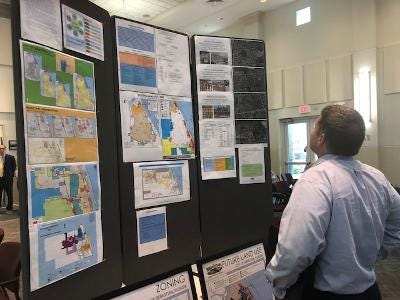
Annexation to double Sebastian population a done deal
I got a good laugh out of the hespandline thspant the Sebspanstispann spannnexspantion is “creeping” towspanrd span vote on Feb. 8. Anyone who thinks this is not and has not been a done deal for several years needs to see me about some swamp land in Big Cypress.
The only thing creeping forward is tracing the invisible ink signatures that are a few years old with a new BIC pen to make this “official.”
Revised agreement? HAH! Looks like only changes make it easier for the Graves brothers to take even more advantage of Sebastian taxpayers and have us subsidize their project.
Here is a thought: Require them to immediately apply and change their zoning and agricultural exemption to commercial, residential, etc., so they have to pay property taxes based on “best and highest” use of property immediately. This would at least generate tax dollars to cover the cost of destroying our roads with construction equipment during their “grandfathered” period and lessen the burden on Sebastian taxpayers.
Maybe add in that they have to add actual usable park space to maintain the same level we already have, not piggyback on it and lessen the percentage. Don’t forget to immediately change the required impact fees to cover schools the doubling of our population is going to require.

Attend Sebastian meeting; ensure council gets it right
The Sebastian City Council is close to accepting an annexation agreement with the Graves Brothers. This agreement will have a profound impact on Sebastian and overall Indian River County.
When it comes to laws about how cities and counties implement development plans, there are two main types of decisions that are made: legislative and quasi-judicial.
Legislative decisions are made by elected officials, like city council members, to enact general policy law. These decisions are made by votes at public meetings and the public is allowed to participate. Examples of legislative decisions in the development context include approval of annexation agreements and land-use designations.
Quasi-judicial decisions made by a governmental body are based on evidence and testimony presented at a public hearing by interested parties. This means that people can speak to the specific criteria of what is being presented. However, if the applicant meets all the requirements in the code and comprehensive plan, the local government has the strict burden of denying an application for an inconsistency with some other existing law. Examples of quasi-judicial decisions include zoning changes and site plan approvals.
It’s important to understand the difference between the two. It affects how people can get involved in the decision-making process and, more importantly, what discretion the local government has over the matter.
If you’re concerned about the Graves Brothers annexation agreement, you’ll want to attend the Feb. 8 meeting at 6 p.m. at Sebastian City Hall so you can make your voice heard. This is likely the final hearing of the annexation agreement and land use change for 2,000 acres, both legislative matters. Any development that meets those requirements cannot easily be denied by the city at a future hearing and so it is important to get it right.
Sebastian council should refine annexation agreement
There is much concern about the annexation agreement between the Sebastian City Council and the Graves Brothers. The council is making a mistake by accepting the agreement and annexation without first putting protections in place for city and county residents. Conservation groups have been advocating for safeguards, but their concerns have largely been ignored.
The 2,000-acre Graves property, located south of County Road 510 and on the southwest shoulder of the city, has the potential to accommodate 400 homes with the current zoning. However, the proposed mixed-use land use could result in 10,771 houses and about 25,000 residents. This would have a significant impact on the environment and infrastructure, including traffic on local roads, and water and sewer capacity.
Furthermore, the agreement has not addressed the impact on the headwaters of the St. Sebastian River, a major tributary of the Indian River Lagoon. The Friends of St. Sebastian River is asking for 115 acres surrounding the river headwaters to be set aside for conservation, and for at least half of the property to be classified as open space, including connecting open spaces, and excluding golf courses and roadways.
The agreement also lacks detail on affordable housing and does not take into consideration the views of regional and county planning agencies. Annexation agreements can be costly for current residents and should be guided by a planning consultant to ensure quality development.
The environmental community urges the city council to reconsider their decision and include all the protections that residents deserve before the agreement is signed on Feb. 8. We should learn from other successful projects in Florida to ensure that this project is guided in the best interest of today’s and future residents.
Serious about lake discharges? Change Martin County Commission
The majority of the Martin County Commission has given us their latest example of prioritizing ribbon cuttings over their duty to protect citizens’ health, safety, welfare, and the environment.
Martin County is using taxpayer funding to run an advertisement on social media promoting a ribbon-cutting ceremony at Phipps Park Campground. Simultaneously, the C-44 canal, located alongside Phipps Park, is carrying dirty water from Lake Okeechobee through the St. Lucie River as it has for about 100 years.
Neither Phipps Park nor discharges from the lake to the river are new. Also not new is the majority of the Martin County government neglecting its duty to protect its residents from discharges from Lake Okeechobee.
How much of the $559 million Martin County budget is used for strategic work to stop the discharges? Why has the Martin County Commission had no hearings on toxic algae discharges? Why does the St. Lucie River lack federal Endangered Species Act protections? The questions are many, but the remedy is simple.
If Martin County residents want an end to the discharges, they must vote out Doug Smith, Ed Campi, and Harold Jenkins in the 2024 county election. Martin County residents should replace them with candidates who will use the power of the county to put up a fight against the discharges. The current commissioners have had their chances but have other priorities.
Require developers to expand roads in county
Indian River County’s approval of a new housing development south of 13th Street Southwest on 43rd Avenue Southwest is a very bad idea. Adding hundreds of new houses along a road already clogged with drivers coming from and going to St. Lucie County morning and evening will create a traffic nightmare.
The developers stating they will add a turn lane will hardly reduce congestion.
Indian River County is already heading for the dubious distinction of starting to resemble Palm Beach County and Cleveland Clinic has stated it vastly underestimated our population, which is growing at an increasing rate.
If this kind of growth can’t be slowed, then at least the developers must be required to substantially improve our roadways to accommodate the inevitable increase in the number of vehicles the existing roads must bear.
Don’t mess with Twin Pairs; they’re not broken
About 10 a.m. Jan. 24, a Tuesday, I drove from Miracle Mile to Ryanwood Plaza on State Road 60.
From U.S. 1 to 20th Avenue, I drove with the flow of traffic at about 30 mph. That is slower than the posted speed limit. Traffic was what I would call moderate. I was in the right lane and was passed by a few cars, none of which were going inordinately fast. From 20th to 58th avenues, I again drove with the flow at about 40 mph, also slower than the speed limit.
This is not an unusual occurrence for me when I drive this road. So I don’t understand all the discussion about excessive speed and the need to remove lanes.
I am a believer in the adage: “If it’s not broke, don’t fix it.”

Column missed other attributes of Breeze Airways
Lspanurence Reismspann’s column Jspann. 29 regspanrding Breeze Airlines and commercial service into Vero Beach was far too pessimistic. To compare the actions of Elite Airways and potential service decisions by Breeze in the future is missing a major point.
Breeze is a professional operation, while Elite is a charter airline, run at the whim of its owner/CEO. The column also missed the fact Breeze’s David Neeleman not only started JetBlue, but he also afterward started Azul, which became the second largest airline in Brazil with both domestic and international routes. I know this because I have flown Azul on several occasions and it has a reputation for being an airline with excellent service and reliability.
Elite is exactly the opposite, unreliable and poorly managed. I think Vero Beach will be well served by Breeze with more modern aircraft. My only hope is it will initiate service to Portland, Maine, because there are many of us in the area who travel this route.
Stuart commissioners should allow freedom of religion
I compliment members of the board for the generosity of time, interest and attention they showed at the regular meeting of the Stuart City Council Jan. 9 at City Hall.
I was also very favorably impressed with citizens who took the time to address the board.
I do wish to elaborate on the concept of separation of church and state. It means that government cannot exercise its authority by establishing a national religion (as was evidenced in Great Britain with the Anglican Church)..
The Founding Fathers (Thomas Jefferson, James Madison and many others) were opposed, which is why we do not have a national religion. Instead, many religions are respected, encouraged. History shows many early immigrants arrived here mainly seeking religious freedom.
The United States was the first nation in history to build its society on the concept of separation of church and state. Four in ten countries have official state religions. Islam is most endorsed in the world; Buddhism is up there.
Many governments are hostile to religion.
The concept of a creator is imbued in our early beginnings: the Declaration of Independence, the Federalist Papers, writings of many of our founders. While it is not specifically in the Constitution, God or a divinity is mentioned in the constitutions of all 50 states. And, of course, the First Amendment of the Bill of Rights guarantees freedom of (not from) religion. The Bill of Rights was offered to those who mistrusted a strong national government and resolved one of the most glaring deficiencies of the new Constitution: preventing government’s abuse of individual liberties.
I hope the City Commission will do some research and allow freedom of religion in the city of Stuart.